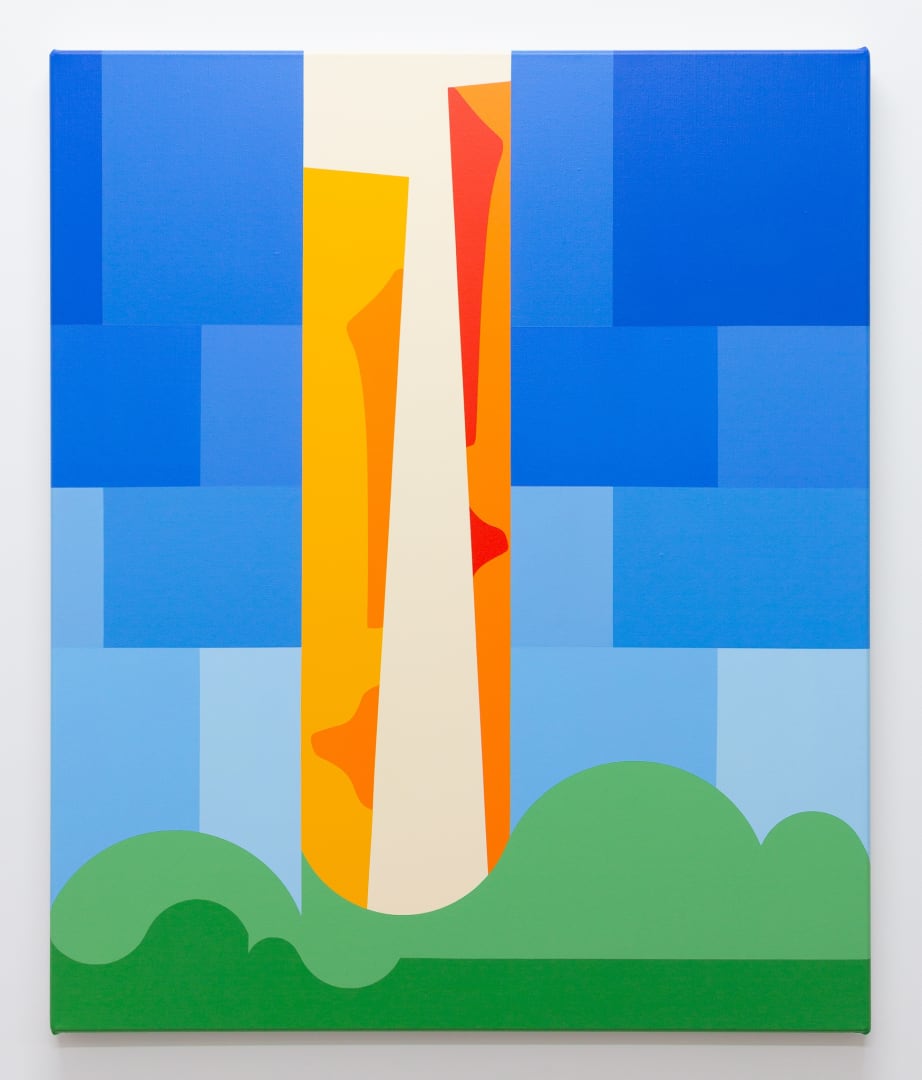Sumer is pleased to present At Once Bridge and Chasm, an exhibition of new paintings (all 2022), by Sydney-based artist, Ella Sutherland. This is the artist’s second solo exhibition at the gallery.
Sutherland’s approach to making is broad and interdisciplinary, with her practice encompassing painting, printmaking, sculpture, installation, and publishing. Her work is primarily visual in nature, and non-verbal (at least in the strict sense). It speaks to artistic traditions such as post-painterly abstraction and hard-edge painting, and yet the works also contain the clear and unmistakable use of type and pre-existing graphical forms; albeit ones that appear to be used solely as compositional elements—scaffolds upon which she constructs images or compositions, and whose textual meaning, if there were any, is obfuscated. This use of type and graphical form, as well as its rendering of (highly stylised) representations of spaces and things, whilst playful and chic, nevertheless corrupt any notion of a ‘clear view’.* Sullying the purity of non-representational space, and thus breaking with those traditions with which they share a formal language.
Sutherland views this body of work as a series of vignettes, relating to modern ideas of communication. Behind Sutherland’s work sits a deep appreciation of social histories, of writing, and of books in themselves. In her work she melds and reimages a variety of recorded histories (both visual and textual), which reflect and illuminate her lived experience: as an artist, as a queer woman, and more universally, as a person living in a time dominated by forms of digital communication. The objects and texts that she references are multifarious; they reach back through time, connecting the archaic and modern with the present.
There is a deliberate queering in Sutherland’s work. Objects are suggestive, veiled, folded, partial in view. She often speaks of the expression of “turning away”, and “refusal”.** A negation of normativity, at least in terms of what is deemed convention or tradition; the presupposed ‘rules’. (Though admitted, such ‘rules’ have always been a somewhat suspect notion when applied to the avant-garde.) In previous works, as here, Sutherland choses to predominantly focus upon (iconic and aberrant) examples of European modernism from within the realm of architecture rather than art, wherein its doctrine and principles are more strictly and forcefully codified—not to mention overtly masculine and sexist—both in terms of theory and practice.
Notably we see Sutherland’s paintings acutely manifesting simultaneity – or as suggested by the exhibition title – the dualism of communication.*** The ‘things’ in her paintings, whilst often partially obscured, can be seen as operating both literally, as objects (i.e. a typeface or French curve), and figuratively, as representations (i.e. as a landform, a cloud, a curtain or a body, or rather, bodies). They oscillate between these two states constantly.
Furthermore, her active use of metaphor and allegory is an aspect of the paintings which seems altogether honest and simple—in so much that it reflects our broader collective understanding of art. That is to say, that art is understood as being intrinsically contextual, connected and fluid. Inherently oblique, the paintings carry a richness of references for those who choose to delve deeper, for those that choose to care. And significantly, the modality in Sutherland’s work, also mirrors one of queer culture (both historical and current). And so too it may be of little surprise then as to why art is so often generally viewed with an air of suspicion by social and political conservates—for being something which is inherently destabilizing and possibly dangerous, especially when it is also embodies a certain allure of beauty, sex and verve.
Ella Sutherland (b. 1987, Auckland, New Zealand) lives and works in Sydney, Australia. Her work has been shown widely throughout New Zealand and international venues including Monash Museum of Art, Melbourne; UNSW Galleries, Sydney; 12th Gwangju Biennale, Gwangju and Objectspace, Auckland. She was the recipient of the 2020 Creative New Zealand Visual Arts Residency at the Künstlerhaus Bethanien, Berlin, which has been postponed till October 2022.
*Colomina, Beatriz, and Jennifer Bloomer. 1992. Sexuality & Space. New York, N.Y.: Princeton Architectural Press.
**Love, Heather. 2007. Feeling Backward: Loss and the Politics of Queer History. Cambridge, Massachusetts; London, England: Harvard University Press.
***Peters, John Durham. 2012. Speaking into the air: a history of the idea of communication. Chicago: University of Chicago Press.


